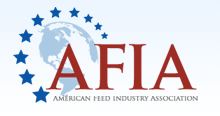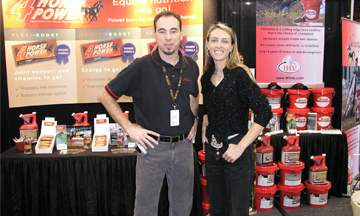Last month during the American Feed Industry Association (AFIA) Purchasing and Ingredient Suppliers Committee in San Antonio, a group of fifteen equine leaders met to discuss the idea of forming an Equine Committee. The group discussed the current issues in our industry and how an Equine Committee within the AFIA could help address these issues. There was a tremendous about of energy in the meeting as it was clearly agreed upon by the group that not only is this committee needed but we could make a major impact on the industry.
 The idea for this committee started back in the summer of 2009 when I had the opportunity to discuss the idea with AFIA President Joel Newman. Joel embraced the idea and made a trip to Colorado to discuss preliminary thoughts on the objective of the committee. Less than a year later, the idea is one step closer to reality as Joel gathered a group of leaders in San Antonio to discuss forming this first-ever Equine Committee within the AFIA. The initial meeting in March included leaders from Hallway Feeds, cheetahLink, Triple Crown, ADM, AlfaGreen Supreme, Blue Seal Feeds, Alltech, MARS Horsecare, Southern States Coop, Cattleman’s Choice Loomix, Nutreco, Pennfield Corporation and Seminole Feed.
The idea for this committee started back in the summer of 2009 when I had the opportunity to discuss the idea with AFIA President Joel Newman. Joel embraced the idea and made a trip to Colorado to discuss preliminary thoughts on the objective of the committee. Less than a year later, the idea is one step closer to reality as Joel gathered a group of leaders in San Antonio to discuss forming this first-ever Equine Committee within the AFIA. The initial meeting in March included leaders from Hallway Feeds, cheetahLink, Triple Crown, ADM, AlfaGreen Supreme, Blue Seal Feeds, Alltech, MARS Horsecare, Southern States Coop, Cattleman’s Choice Loomix, Nutreco, Pennfield Corporation and Seminole Feed.
During the meeting, the group established a number of isses that we believe the Equine Committee could address to help further the equine industry. Among those issues we established the three most pressing concerns that need to be addressed.
- Unwanted horse issue – Currently there is a lack of information regarding the total number of unwanted horses existing in our nation but general consensus is that number is well over 100,000. This is an issue that needs to be addressed as the number of unwanted horses is having a dramatic affect on the industry. Due to the large surplus in unwanted horses, breeding is down which has a direct negative affect for veterinarians and breed associations. New horse purchases are down both in number and value. This is an issue that the AFIA Equine Committee will take serious and look to industry leaders and organizations for help in developing a plan that works for everyone in the industry.
- Product labeling – There is a tremendous variability in labeling interpretation from state-to-state. The AFIA has been very successful in working with state regulators in other industries so we hope to have the same level of success in the equine industry.
- Quality assurance – There is a lack of consistent quality assurance in the equine feed industry. This ranges from manufacturing processes to ingredients. The AFIA currently has a program called Safe Feed/Safe Food which is an option to help address this issue. The Safe Feed/Safe Food Certification Program is a voluntary, independently certified program designed for the total feed industry. The Safe Feed/Safe Food program establishes comprehensive standards of excellence that go beyond existing regulations to maximize food and feed safety.
There were other issues addressed during the meeting as well including product registration in Canada, state tax and registration fees, foster youth participation in the industry and lack of standards for “low starch” horse feeds. One other major issue this committee will discuss is the definition of a horse in whether they fall under ‘livestock’ or ‘companion animal’. How horses are defined by state and federal governments will have a major impact on several issues (unwanted horses, ingredient usage, labeling, taxes, etc.).
One member of the group who attended the meeting was Jeff Pendleton, General Manager of Hallway Feeds (Lexington, KY). “Instead of individuals addressing issues/concerns alone, having a group effort with focus will accomplish much with greater efficiency,” said Pendleton. “This template will allow the AFIA Equine Committee to work for the betterment of all Equine feed manufacturers.”
Jarrod Kersey, Director of Ingredients and State Legislative Affairs for the AFIA, has been selected as the staff contact and leader for this committee. Jarrod believes that the Equine Committee will be a valuable tool and resource for the industry.
“AFIA is excited about the interest expressed by the feed industry to develop a committee dedicated to the regulatory and legislative feed issues facing the equine industry,” said Kersey. “The issues impacting the equine industry vary from feed labeling to trade to a host of other issues involving state departments of agriculture, FDA Center for Veterinary Medicine to federal legislation. With FDA promulgation, Animal Feed Safety System and the various food/feed safety bills out there, the timing couldn’t be better. An Equine Committee focused on feed has the ability to make a difference by education and lobbying efforts focused on equine issues.”
There are a few final steps that need to take place before the Equine Committee is officially approved by the AFIA. A proposal that includes the committee’s mission, objectives and 2010-11 Action Plan needs to be finalized. We also need to propose an initial slate of Committee members and identify future meeting times and locations. All of these items will be presented at the AFIA Board Meeting in May for approval. We are optimistic the Board of Directors will approve the Equine Committee as we all believe this committee will serve the equine industry and the AFIA well both short-term and long-term.
If you would like to learn more about the AFIA Equine Committee or how your company can be more involved in the AFIA email me at pmunsch@cheetahlink.com or contact AFIA President Joel Newman at jnewman@afia.org.
About cheetahLink
Founded by Preston Munsch, cheetahLink is an online marketing and consulting firm that specializes in the animal health industry. The focus of cheetahLink is to increase sales, brand recognition, online visibility and website traffic through search engine optimization, website development, social media site marketing (Facebook, Twitter, LinkedIn, etc.) and other online marketing services. CheetahLink also provides consulting services for animal health companies including product development, business development, sales/distribution plans, contract manufacturing, and other services. Munsch has spent the past 10 years in the animal health industry specializing in product development, animal health marketing, branding, sales, distribution and advertising. Munsch has a Masters Degree in Business Administration along with a Bachelors Degree in Communication and Associates Degree in Graphic Design. If you have any questions regarding our services feel free to contact us at 720.244.2034 or pmunsch@cheetahlink.com.



